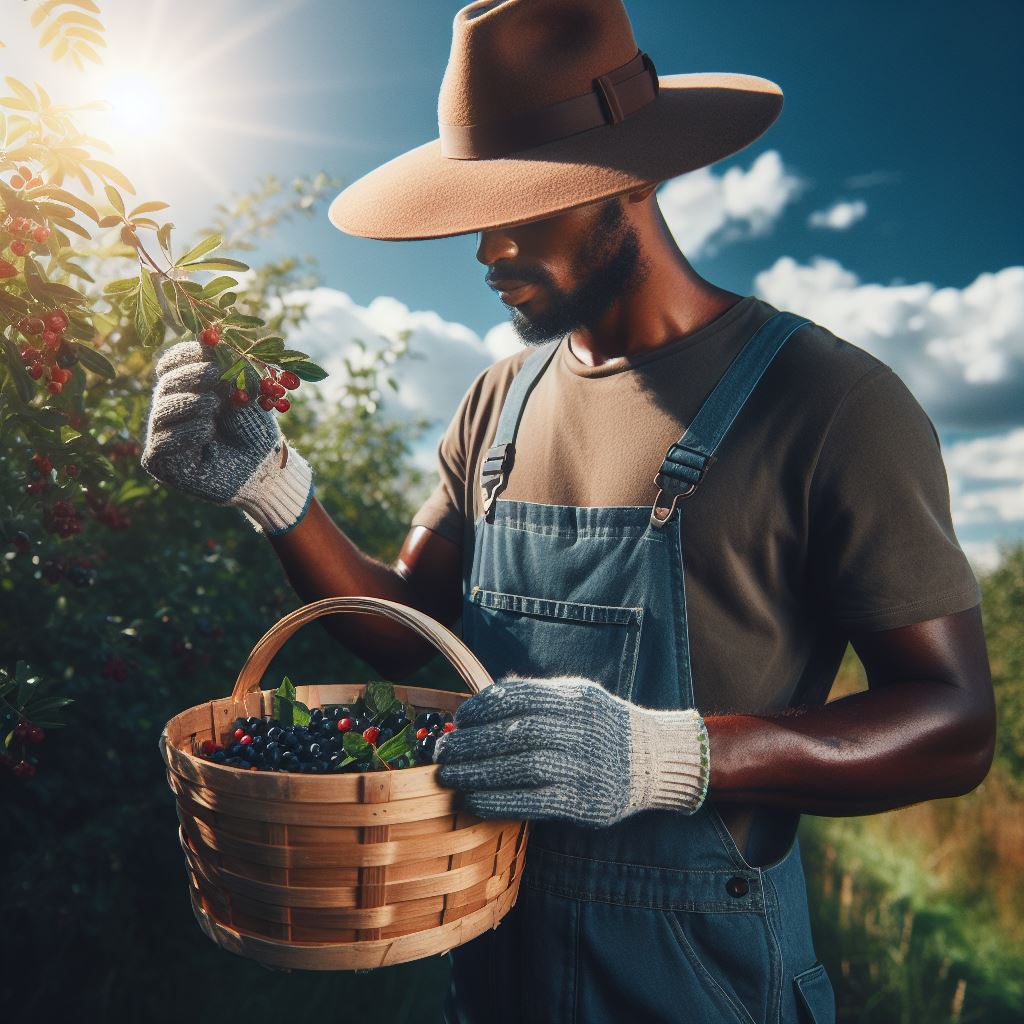Introduction
Importance of harvesting berries
Harvesting berries is important for both commercial and home gardeners.
Berries are a beloved fruit known for their juicy and sweet flavor, making them a favorite among many. Whether you have a small berry patch in your backyard or own a large-scale berry farm, knowing when and how to harvest your berries is crucial.
Overview of the topic
This blog post provides an overview of the timing and techniques of harvesting berries.
Timing is key when it comes to harvesting berries. Waiting too long can result in overripe, mushy fruits, while harvesting too early can mean missing out on the optimal flavor and sweetness.
Understanding the optimal time to harvest will ensure the best taste and quality of your berries.
In addition to timing, the techniques used during berry harvesting are equally important. Carefully picking each berry to avoid damage or bruising ensures that they remain fresh and appealing.
Proper handling and storage are vital to extend the shelf life of the harvested berries.
Different types of berries have specific harvesting requirements. Strawberries, for example, should be picked when they are fully red and have reached their maximum size.
Blueberries, on the other hand, should be harvested when they have turned a deep blue color and come off the stem easily.
Purpose of the blog post
The purpose of this blog post is to guide readers on when and how to harvest their berries effectively.
In this blog post, we will delve into the timing and techniques of harvesting various types of berries. You will learn the signs to look for when determining the right time to harvest your berries and the best practices to ensure a bountiful and delicious harvest.
Stay tuned for our upcoming sections as we explore each type of berry individually and provide detailed harvesting guidelines that will help you make the most out of your berry patch or farm.
Read: Soil Health: Boosting Crop Quality & Yield
Understanding the Timing for Harvesting Berries
Factors affecting the timing
Berry variety
The type of berry you’re growing will determine the specific timing for harvesting.
Climate and weather conditions
The weather and climate in your region will impact the ripening process of the berries.
Transform Your Agribusiness
Unlock your farm's potential with expert advice tailored to your needs. Get actionable steps that drive real results.
Get StartedSoil and growing conditions
The quality of the soil and growing conditions can affect when berries reach maturity.
Signs of ripeness
Color
When the berries have reached their ideal color, it’s a sign of ripeness.
Texture
A ripe berry will have a soft texture, indicating it’s ready to be harvested.
Taste
Tasting a berry is one of the best ways to determine if it’s ripe and ready for harvesting.
Importance of harvesting at the right time
Harvesting berries when they’re at their peak is crucial for the best flavor and overall quality.
If berries are harvested too early, they may lack sweetness and nutritional content.
On the other hand, if berries are left on the plant for too long, they can become overripe and start to decay.
Timing is essential to maximize the yield and ensure the berries have the perfect balance of flavor.
Harvesting at the right time also prevents pest infestations and reduces the risk of diseases affecting the berries.
Additionally, picking the berries when they are ready helps to promote healthy plant growth and future yields.
Read: Pest Control: Protecting Crops Pre-Harvest
Techniques for Harvesting Berries
Tools and equipment
- Berry baskets or containers
- Pruners or scissors
- Gloves
Berry baskets or containers are essential tools for harvesting berries. They provide a convenient way to collect and transport the delicate fruits without causing damage.
Pruners or scissors are necessary for easily cutting the ripe berries from their stems. This helps in preventing any unnecessary force on the plants, avoiding possible harm.
Gloves are highly recommended to protect your hands from thorns and potential allergic reactions. They also provide a better grip on the berries and prevent any accidental injuries.
Proper handling and storage
- Gently picking without damaging the plant
- Sorting and removing damaged or diseased berries
- Tips for storing berries
When harvesting berries, it’s crucial to practice gentle picking to avoid damaging the plant. This involves holding the berry gently between your thumb and forefinger and lightly twisting it off the stem.
Sorting through the harvested berries is important to remove any damaged or diseased ones. This prevents the spread of diseases and ensures that only quality berries are stored and consumed.
Proper storage is essential for extending the shelf life of your freshly harvested berries. Store them in a cool place, such as the refrigerator, in breathable containers to maintain their freshness for a longer period.
Harvesting methods for different berry types
- Strawberries
- Blueberries
- Raspberries
Strawberries should be harvested when they are fully red and ripe. Gently pull the berry from the stem, making sure not to remove the green calyx, which helps in preserving the fruit.
Blueberries are best harvested when they have turned a deep blue color. Hold the cluster of berries in one hand and use your other hand to lightly roll and detach the ripe berries into your container.
Raspberries should be gently picked when they are fully ripe and easily come off the plant with minimal effort. Use your fingers to gently tug the ripe berries, ensuring they stay intact.
In summary, harvesting berries requires the right tools, proper handling, and knowledge of the specific techniques for each berry type.
With the use of berry baskets, pruners, gloves, and careful handling, you can ensure a successful harvest while maintaining the quality and freshness of the berries.
Remember to sort out any damaged or diseased berries and store them appropriately for longer shelf life. Follow these techniques, and you’ll be able to enjoy the delicious taste of freshly harvested berries straight from your garden.
Read: Storing Potatoes: Post-Harvest Tips
Showcase Your Farming Business
Publish your professional farming services profile on our blog for a one-time fee of $200 and reach a dedicated audience of farmers and agribusiness owners.
Publish Your Profile
Best Practices for Maximizing Berry Harvest
Regular inspection of the plants
Inspect your berry plants regularly to identify any signs of pests, diseases, or nutrient deficiencies.
Regularly check for any wilting, yellowing, or discolored leaves, which could indicate nutrient deficiencies.
Look for any signs of pests, such as holes in leaves or webs, and take immediate action to prevent further damage.
Monitor the plants for any signs of diseases, such as spots or lesions on leaves, and take necessary steps to control them.
Implementing a harvesting schedule
Create a harvesting schedule to ensure that you pick the berries at the peak of their ripeness.
Know the specific ripening time for each berry variety and mark it on your calendar.
Check the berries daily as the harvest time approaches and start harvesting when they are fully ripe.
Avoid leaving the berries on the plants for too long, as they can become overripe and attract pests.
Proper care and maintenance of berry plants
Maintaining the health of your berry plants is crucial for maximizing your harvest.
Fertilizer application
Apply a balanced fertilizer, specifically formulated for berry plants, during the growing season.
Follow the instructions on the fertilizer package to ensure the correct application rate.
Avoid over-fertilizing, as it can lead to excessive vegetative growth instead of fruit production.
Watering techniques
Water your berry plants regularly, especially during dry periods, to maintain adequate soil moisture.
Provide deep, thorough watering rather than frequent shallow watering to encourage deep root growth.
Avoid overhead watering, as it can promote the spread of diseases. Use drip irrigation or soaker hoses instead.
Pruning and removing weeds
Prune your berry plants annually to remove dead or diseased branches and promote better air circulation.
Regularly remove weeds from the area around your berry plants, as they can compete for nutrients and water.
Use organic mulch, such as straw, to suppress weed growth and conserve soil moisture.
By following these best practices, you can maximize your berry harvest and enjoy delicious, healthy fruits. Remember to stay consistent with inspections, adhere to a harvesting schedule, and provide proper care and maintenance to your berry plants. Happy harvesting!
Read: Apple Picking: Timing for Perfect Fruit
You Might Also Like: Eco-Friendly Pest Control in Crop Management
Conclusion
Recap of the key point
A recap of key points reveals the importance of timing and techniques in berry harvesting. It is crucial to experiment and determine the optimal methods for specific berry varieties and growing conditions.
Importance of timing and techniques in berry harvesting
Timing and techniques are crucial in berry harvesting to ensure optimal fruit quality and yield. Harvesting at the right moment preserves flavor and nutritional content.
Proper handling techniques prevent damage and maintain freshness. These practices maximize productivity and profitability while meeting consumer expectations for high-quality berries.
Encouragement to experiment and find the optimal methods for specific berry varieties and growing conditions
Experimentation is key to discovering optimal harvesting methods tailored to specific berry varieties and growing conditions. Farmers should embrace trial and error, observing how different techniques affect fruit quality and yield.
Through experimentation, they can refine their practices, enhance efficiency, and achieve the best results for their berries.




